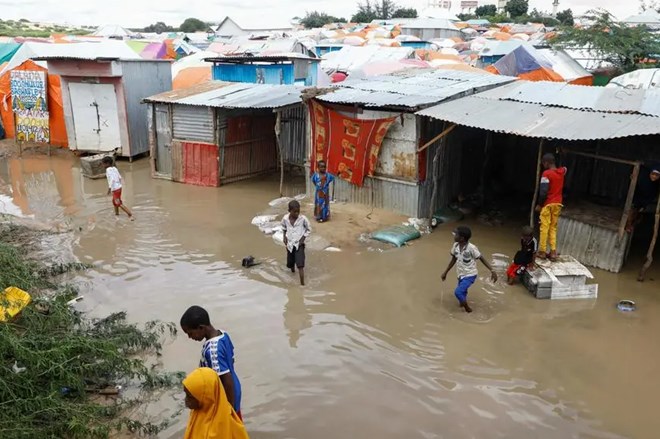
Mohamed Olad Hassan
Sunday November 12, 2023

Somali children wade through floodwaters outside their makeshift shelters following heavy rains at the Al Hidaya camp for the internally displaced people on the outskirts of Mogadishu, Somalia, Nov. 6, 2023
Somalia’s government warns that flooding which has uprooted hundreds of thousands of people may turn into the country’s worst humanitarian disaster in decades, unless Somalis and the international community act quickly.
"The situation is dire, and the extent of the human impact of the floods is rearing its ugly face. We are calling for the Somalis in the diaspora and the international community to urgently respond to the situation before it turns into bigger humanitarian catastrophe," the head of the National Disaster Management Agency, Mohamed Mo’alim Abdulle told VOA Somali on Thursday.
He said the flooding has killed 29 people and forced more than 300,000 to flee their homes in the southern and central regions of Somalia.
Worst-hit regions
Somali authorities say the worst-hit areas are in the Southwest and Jubbaland states.
In Baidoa, about 225 kilometers southwest of Mogadishu, residents continue to stay in the open as the flooding water left their homes completely under water.
"We have been spending [our time] outside in the open for a week. We have no shelter, food and all our belongings and our house are under water," Madey Osman, a father of seven, told VOA Somali.
"I have nowhere to go; there is no guarantee that I will receive aid if I run to another place. We have decided to wait our fate here," said Markabo Malaq, a single mother raising eight children.
Abdulkadir Ali Mohamed, chairperson of the regional state agency for internally displaced people affairs, said the flooding has also affected IDP camps in the outskirts of the town, which was already hosting hundreds of people displaced by an Islamist insurgency and the worst drought in the country in four decades.
"We have seen traumatized families fleeing for a third time with no hope on the horizon," said Mohamed.
Mohamed Hussien Hassan, former regional justice minister, is concerned the circumstances will lead to the spread of diseases or worse.
"When people have no shelters, and the drinking water and the entire environment is contaminated with human waste from the local poor sewage system and the latrines, you only expect the spread of diseases like cholera and malaria," said Hassan.
"When people cannot work or harvest, you only expect hunger and malnutrition which can eventually degenerate into famine," he added. "We fear that this situation turns into shocking humanitarian disaster."
Baidoa was once nicknamed "the City of Death." It earned the title in 1992 when war and famine claimed the lives of more than 220,000 people, many left dying in the streets.
The city is also known for the 1993 visit by former U.S. President George H.W. Bush, who committed the U.S. military to a mission that saved thousands of innocents from death during Operation Restore Hope.
Meanwhile, according to local officials, in the southern Somali state of Jubbaland, there is no access to tens of thousands of families trapped by flood waters.
"The flooding has destroyed bridges and roads and cut the entire access to more than 70,000 families. There is a big fear of [a] humanitarian catastrophe," the president of the state, Ahmed Mohamed Islam, better known as "Madobe," warned.
"Several nights of heavy rainfall compounded major flooding in Bardhere and Luuq, towns in the Gedo region, leaving hundreds of thousands of people completely under water," said Gedo Deputy Governor Mohamed Hussein Al-Qadi.
"Most of the areas are only accessible with boats, and we have no capacity to airlift aid or carry out rescue mission[s], which means the needy, trapped families will remain helpless, until the land dries and they are able to move [on] their own," said Al-Qadi.
Large parts of both the Southwest and Jubbaland states are under control of al-Shabab militants, which makes it difficult for the government and aid agencies to reach those in need.
On Thursday, heavy floods swept the streets of the country’s capital, Mogadishu. Photos and videos shared on social media showed women, children, old people, and even motorized three-wheeled rickshaws swept away by floodwaters.
"In more than 14 years, I have lived in Mogadishu and through history; I have never seen or heard of floods of such extent in Mogadishu," Osman Mohamud, one of the city’s residents told VOA.
The United Nations has described the flooding in Somalia and neighboring countries as a "once-in-a-century event."
Around 1.6 million people in Somalia could be affected by the heavy seasonal downpours, which have worsened by the combined impact of two climate phenomena, El Niño and the Indian Ocean Dipole, the U.N. Office for the Coordination of Humanitarian Affairs (OCHA) said in a statement late Thursday.